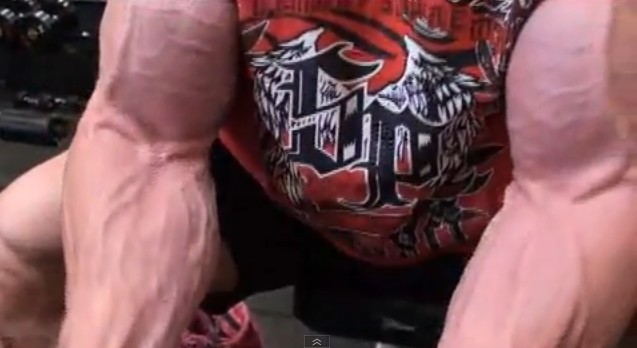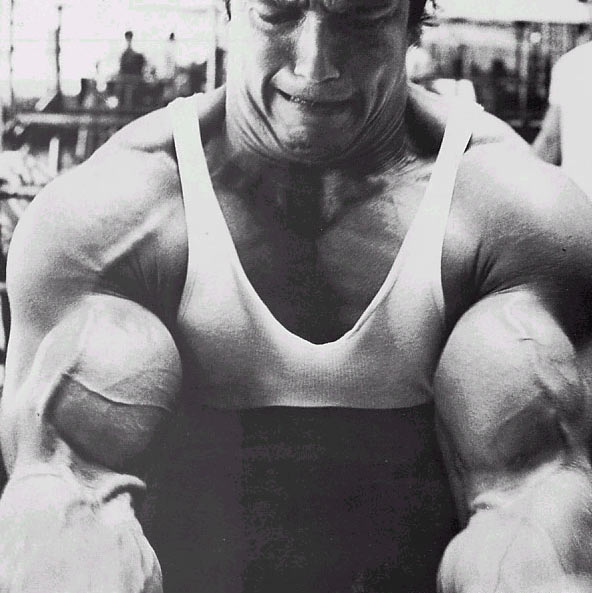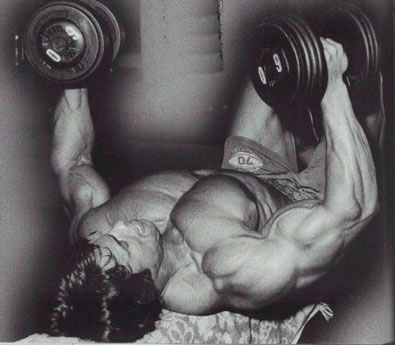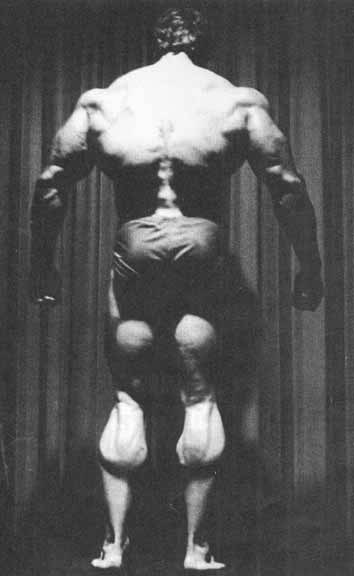How to get a giant pump
Get A Big Pump If You Want Big Gains
The importance of "the pump" dawned on bodybuilders a long time ago. So much so that the word "pump" itself has been associated with bodybuilding for many years now
Discover how you can use its anabolic effects to build the physique you've always wanted! You can easily incorporate this proven bodybuilding technique into your workouts today to trigger gargantuan gains in muscle size. //www.youtube.com/watch?v=aUBcoBmnIjQ
Nitric oxide (NO) has a vasodilating effect on muscle tissue that is very similar to what occurs in the genital region when one takes Viagra or Cialis.
"Vasodilating" means that the body responds to nitric oxide by opening the veins, arteries and capillaries like little flood gates. This vasodilation over-fills the muscle with nutrient dense blood to produce a huge pump... much bigger than could normally be achieved without NO. We explained this in the previous article on Viagar – Cialis and Levitra

How important is the pump for muscle growth? Let's look at an example: Many Olympic weightlifters and powerlifters train for increases in muscular strength and power... but don't have the muscle mass of most bodybuilders. Why is that? It's simple. Their style of training does not produce a pump like the training a bodybuilder does. They get stronger... but not a lot bigger. That's why bodybuilders have known for years that consistently getting a good pump in the gym is crucial for muscle growth. Those who do not get a pump from their training are unable to attain their full size potential.
The life of the human body is in the blood. If any part of your body loses its connection to the blood supply, it starts to die. The opposite is also true. A healthy connection to the blood source allows any part of the body to live and thrive. One of the functions of the blood is to deliver nutrients to the body necessary for growth. For bodybuilders, this is especially important. Adequate blood flow ensures the nutrient support that promotes the growth of muscle tissue. So let's take a look at the importance of the pump and its role in muscle growth.
It is thought that during training, a muscle can receive up to four times the amount of blood it would ordinarily get. Why exactly do the muscles need all this blood? As mentioned, the muscles require sufficient oxygen and nutrients to continue the sustained contracting that results in a pump.
 Waste products also require removal, for the muscles to continue their work. Ultimately, muscles need blood to work effectively and recover quickly after exertion. If the muscles are working effectively, muscle growth will result.
Waste products also require removal, for the muscles to continue their work. Ultimately, muscles need blood to work effectively and recover quickly after exertion. If the muscles are working effectively, muscle growth will result.
Muscle growth will also result from the fascial stretching that occurs when the muscle is pumped beyond its normal size. When this fascial layer (which can be found between the skin and the muscle) is stretched, room for continued muscle growth is made available. This stretching also induces musclegrowth through growth hormones – mechano growth factors - Insulin-like growth factors.
Over time, the pump will also create a greater number of capillaries (tiny blood vessels), which will, in turn, provide the muscles with more nutrients and oxygen and allow for larger pumps and more growth in the long term.
Get A Big Pump If You Want Big Gains
To maximize your gains it's best to get as full a pump as possible in a relatively short time frame. Here's one way to do that:
Once you start getting a pump, rest just long enough to catch your breath between sets and hit the muscle again before the pump starts to diminish. Make it a goal of getting a maximum pump for each muscle group at least once a week.
To keep progressing, try to take your pump higher and higher each training session. Here's a simple way to do that I learned from Larry Scott, the first Mr. Olympia: Let's use arms for this example. (Every bodybuilder wants bigger arms.) Write down the best measurement you've ever gotten on your arms when pumped to the max. Let's assume the best you've ever taped is 16 and 1/8 inches.
On your next arm training session you're going to shoot for 16 1/4 inches. (An extra 1/8 of an inch is about all you can reasonably expect from session to session.)
Your goal is to get the best pump possible with the least amount of sets and reps. I recommend you keep your reps in the 6 to 8 range. That will allow you to handle some fairly heavy weights while still getting in enough sets to get a good pump.
So after your training session you measure your arm and it measures 16 1/4. You achieved your goal of an extra 1/8 inch pump this training session!
This makes you feel motivated so you decide to do another set.
After cranking out the last reps and feeling the pain (and pleasure) of the lactic acid burn and resulting pump... you measure your arm again only to discover it has gone down to 16 1/8.
Bummer! It actually shrank! What gives?
You've done one set too many... but it feels like your arm is bursting! You can't believe it has actually taped less than it did just one set ago, but it's true.
It's a common mistake. You've over-trained by one set. It's impossible to tell by looking and you definitely can't tell by feel... but the tape doesn't lie.
The tape will tell you the magic number of sets that will give you the best possible pump. Don't do too many sets and don't do too few. Let the measuring tape be your guide.
With a little experimenting, you'll get more sensitive to the exact number of sets you need to perform in order to get the maximum pump possible.
This growth secret isn't restricted to just arms. It can be used on all body parts with equal success. Once you're familiar with this process, it will help you get the maximum possible pump at each training session.
 Bodybuilders have known for decades how important the pump is for muscle growth. Arnold even revealed over 30 years ago that the pump was one of his secrets for building his massive physique.
Bodybuilders have known for decades how important the pump is for muscle growth. Arnold even revealed over 30 years ago that the pump was one of his secrets for building his massive physique.
Arnold Schwarzenegger in Pumping Iron : "The greatest feeling you can get in the gym or the most satisfying in the gym is the pump. Let's say you train your biceps - blood is rushing into your muscles and that is what we call the pump. Your muscles get a really tight feeling like your skin is going to explode any minute and it's really tight like someone blowing air into your muscles. It just blows up and it feels different. It feels fantastic. It's as satisfying to me as cumming is, you know, as having sex with a woman and cumming. So can you believe how much I am in heaven? I'm like getting the feeling of cumming in the gym, I'm getting the feeling of cumming at home, I'm getting the feeling of cumming backstage when I pose out in front of 5000 people. I get the same feeling so I'm cumming day and night. I mean it's teriffic right, so you know, I'm in heaven." –
Pump: A commonly used bodybuilding term is “the pump”. “The pump” occurs when your muscles swell up beyond their normal size by a considerable amount. Looking at yourself in the mirror, you will look bigger, and likely show appear more vascular and defined as well as being more confident in yourself. This pump is normally fast to achieve and shouldn’t take much more than four sets. I find a really good way to pump up is to do pushups until I reach failure, and normally my chest will look bigger than ever. A good pump can be felt and noticed throughout the entire workout if done properly. Oxygen and nutrients will continually to be brought into the area being exercised during intense weight training activity. Blood is forced into the area being exercised but not drawn out. This extra blood stays in there for some period, causing it to swell and appear noticeably bigger. A reason why many people like to pump up before they pose for a picture is to take advantage of this difference in size which occurs.
 Bodybuilder’s High: Similarly to a runner’s high, a pump can, according to some experts, cause a wide variety of hormonal responses, including the release of endorphins and enkephalins, which are natural painkillers produced in the body. Not to get into too much physiology or psychology, the pump can also elicit a pleasurable response in the pleasure center of the brain, which occurs overtime through the association of bodybuilding activity and the satisfying pump felt afterwards. The difference between being pumped up after a workout while in the gym, and waking up the next morning may be so significant that some people are shocked at the way they look when pumped up. Like any other positive outcome of bodybuilding, the pump will only occur if a number of other training factors are in place, such as proper nutrition and rest. One very easy way to determine if you are overtraining is if you notice you are no longer achieving the pump after your workouts. This can easily be noticed if you are familiar with the feeling associate with the pump
Bodybuilder’s High: Similarly to a runner’s high, a pump can, according to some experts, cause a wide variety of hormonal responses, including the release of endorphins and enkephalins, which are natural painkillers produced in the body. Not to get into too much physiology or psychology, the pump can also elicit a pleasurable response in the pleasure center of the brain, which occurs overtime through the association of bodybuilding activity and the satisfying pump felt afterwards. The difference between being pumped up after a workout while in the gym, and waking up the next morning may be so significant that some people are shocked at the way they look when pumped up. Like any other positive outcome of bodybuilding, the pump will only occur if a number of other training factors are in place, such as proper nutrition and rest. One very easy way to determine if you are overtraining is if you notice you are no longer achieving the pump after your workouts. This can easily be noticed if you are familiar with the feeling associate with the pump
Pumping Up Before Bodybuilding Competition.
Amongst other rituals like the tanning, the pumping of the muscles is very important before the athlete steps on stage. They use their bodyweight (push-ups) weights and towels to pump their muscles are full just like their veins to look their best for the jury. See one of the best:
//www.youtube.com/watch?v=i5nAvIFRMBk
Pro bodybuilder, Lee Priest pumping up backstage at the Australian Grand Prix.
And how many of you “pump-up” before they go out?? I guess I’m not the only one.
Burns
You can also do a few partial reps at the end of each set. Larry Scott calls these "burns." They're pretty intense so only do a couple burns on your last set or two of each exercise... NOT on every set.
Bodybuilding burn reps are very similar to split reps, except they’re done as the last few reps of the final set of a bodybuilding exercise. For example, if you were working on building calves with some strict sets of calf raises – going through the full range of motion – you might perform a series of partial range repetitions (in good form) at a faster pace at the end of the final set. This creates a lactic acid build-up that can have your calves feeling like they’ve been hit with a blow-torch – hence the name, “burn reps.”
Bodybuilding burn reps are an ‘intensifying technique. For this reason, they can either lead to greater hypertrophy or they can send you right into an overtraining spiral. Therefore, they must be use selectively and sparingly.
I used calf-building as an example of where to use burn reps for a reason: They’re highly effective when used on exercises for building that particular muscle. The muscle fibers of the calves are so dense; they nearly demand that an intensifying technique like bodybuilding burn reps be used to adequately work them for hypertrophy.
 Think about exercises like ‘leg curls’ for hamstrings, or ‘bent-over lateral raises’ for the rear delts. These two muscles are almost used in total isolation when we work them. In fact, I find it to be an redundancy to perform two hamstring exercises or two rear delts exercises. Additionally, these two muscles are used so very slightly when performing other leg exercises, or delts exercises, respectively. Therefore, they lend themselves very nicely to being responsive to ‘burn reps’ without being susceptible to overtraining.
Think about exercises like ‘leg curls’ for hamstrings, or ‘bent-over lateral raises’ for the rear delts. These two muscles are almost used in total isolation when we work them. In fact, I find it to be an redundancy to perform two hamstring exercises or two rear delts exercises. Additionally, these two muscles are used so very slightly when performing other leg exercises, or delts exercises, respectively. Therefore, they lend themselves very nicely to being responsive to ‘burn reps’ without being susceptible to overtraining.
Some might argue that the front delts are as much a candidate as the rear delts based on these criteria. However, that’s clearly not the case when considering how much extra indirect work the front deltoids get from working pectorals. Likewise, the middle deltoids are pounded pretty hard by the compound movement of overhead presses along with the isolation movement of side lateral raises. Thus, I’ve found that any bodybuilding burn reps done on these movements can easily lead to overtraining.
This goes for pectorals, back, quadriceps, and arms as well. There’s certainly no rule against using ‘burn reps’ for any of these muscles, but I don’t recommend it. My experience with natural bodybuilding has taught me that there’s a fine line between extra stimulatory effects of intensifying techniques and excessive “stimulation” resulting in no growth.
Always remember: Muscles don’t grow directly from your weight workouts; it’s an indirect phenomenon. If you have a schedule of rest days between workouts that precisely recuperates the tissue torn down from a specific amount of training stress, adding intensity is likely the wrong thing to do. Thus, we’d only want to use bodybuilding burn reps if doing so will make the stress on the muscle in question commensurate with what would have it recuperate at the rate of recuperation of the rest of your muscles.
Bottom line: Bodybuilding ‘burn reps’ can be extremely effective on muscles that might be otherwise end up ‘undertrained’ if they’re not incorporated. When you use this technique, implement it with restraint and a careful eye on feedback. Then, only continue using it on movements for which feedback is showing positive effect on volume progress.
Various sources
- Login to post comments


